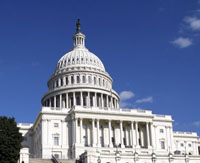
Buffett Rule Targets Capital Gains
4/17/2012
 On April 16, the Senate voted on a bill that would have enshrined the “Buffett Rule” in the tax code, which would have ensured that millionaires and billionaires pay their fair share of taxes. With the bill’s defeat, Congress should consider other options to increase tax fairness.
On April 16, the Senate voted on a bill that would have enshrined the “Buffett Rule” in the tax code, which would have ensured that millionaires and billionaires pay their fair share of taxes. With the bill’s defeat, Congress should consider other options to increase tax fairness.
As millions of Americans scrambled to finish their taxes, the Senate voted to protect the most regressive aspect of today’s tax code. Currently, many wealthy taxpayers pay little or nothing in taxes, with the most prominent recent example being Republican presidential candidate Mitt Romney, who recently disclosed that he paid a tax rate of only 13.9 percent on $21 million in income. Congress’s failure to approve the Buffett Rule indicates its unwillingness to enact a truly progressive tax code.
The Buffett Rule is named after billionaire Warren Buffett, who famously pointed out that his secretary paid a higher tax rate than he did. Buffett (and other extremely wealthy people) often pay low taxes because the majority of their income comes from capital gains and dividend payments, which are taxed at a lower rate than ordinary wages. More than 200,000 millionaires and billionaires pay less than 30 percent of their income in taxes, and the 400 wealthiest taxpayers, all of whom earned more than $110 million in 2010, paid an average of only 18 percent in taxes. By only paying a maximum rate of 15 percent on capital gains income, wealthy taxpayers can pay a lower tax rate than those who earn income through their salaries or wages, which are taxed at a maximum rate of 35 percent. Since the rate for capital gains is less than half the highest tax rate for wages, wealthy taxpayers often have effective tax rates lower than professional middle-class families.
The Buffett Rule in general targets this capital gains preference by instituting a tax floor. Sen. Sheldon Whitehouse’s (D-RI) version of the Buffett Rule would require that taxpayers with annual incomes over $2 million pay at least 30 percent of their income in taxes. The rule is phased in gradually, starting at $1 million, so that these taxpayers would not face a steep tax “cliff” when their income rises above $1 million. According to the Tax Policy Center, the Buffett Rule would affect some 217,000 taxpayers, 1,470 of whom pay no taxes whatsoever (the White House recently released a new tool allowing taxpayers to see how many millionaires paid lower taxes than them).
As an example of how the Buffett Rule would work, take a hypothetical wealthy, married taxpayer. If the taxpayer has $2 million in wages and $8 million in capital gains, assuming no deductions, the taxpayer would only owe about $1.89 million in taxes, or less than 19 percent. This is about the same tax rate as a married couple earning $110,000 a year, even though the wealthy taxpayer earns more than 90 times more. Under the Buffett Rule the Senate rejected, this wealthy taxpayer would have seen his taxes almost double.
While the Buffett Rule would have been a step in the direction of ensuring everyone pays a fair share, a better solution would be to simply raise the capital gains tax rate itself. As noted before, the Buffett Rule essentially targets capital gains income for millionaires and billionaires. However, it would have added a new level of complexity to the tax code. Increasing just the capital gains rate itself, which President Obama has recommended in his latest budget, is both simpler, as it requires no new calculations, and it would raise far more money.
Moreover, insofar as the Buffett Rule limits itself to taxpayers with income over $1 million, it is forgoing billions of dollars a year in lost tax revenue. The Joint Committee on Taxation estimated that the Senate’s version of the Buffett Rule would raise approximately $47 billion over 10 years. Raising the capital gains rate to 20 percent and taxing qualified dividends as ordinary income, as the president recommends, would bring in $242 billion over 10 years. Treating capital gains income as ordinary income, or taxing it at the higher rates for wages, would generate about $900 billion in revenue in the next decade.
Either the Buffett Rule or raising the capital gains rate could raise significant revenue to pay for important federal programs. For instance, in July, federal student loan interest rates are scheduled to double, costing the average loan recipient thousands of dollars over a 10-year period. In 2008, more than a third of all undergraduates had a federal student loan. Keeping the rates low for these students would cost at least $30 billion over the next 10 years. Implementing the Buffett Rule would bring in at least $47 billion over 10 years, more than enough to pay for keeping student loan interest rates low. But raising capital gains rates themselves would do much more, potentially allowing Congress to fix the student loan hole, add graduate students back to the program, and expand the Pell Grant (which helps pay for college for low-income students) to include millions more students.
Raising taxes on wealthy taxpayers, either through the Buffett Rule or simply raising capital gains rates, would have two benefits. The reforms would ensure that everyone pays their fair share in taxes, and they would help raise revenue for crucial public protections and social safety net programs at the same time.


